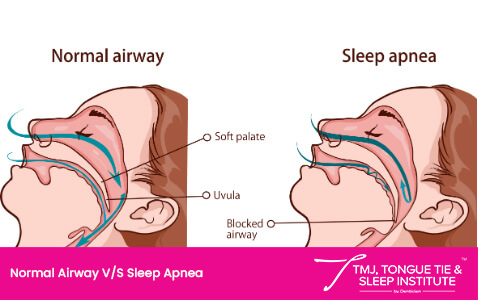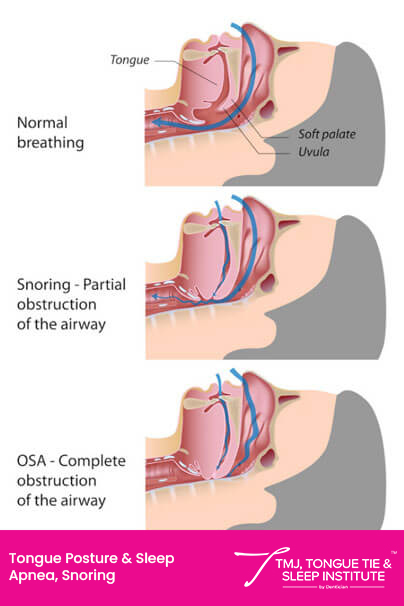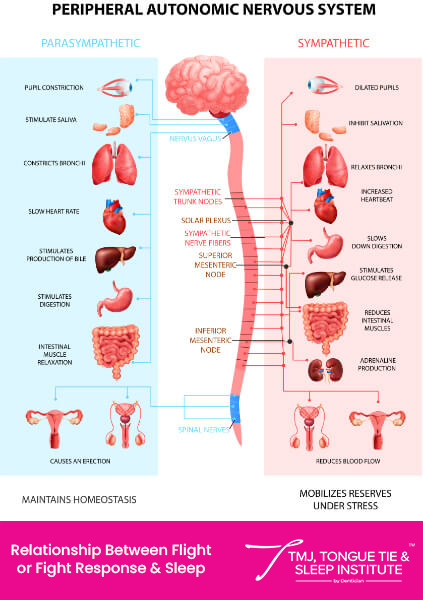Sleep Disorders “OSA & UARS”
The Relationship
Did you know that there is a very strong relationship between you tongue, breathing & quality of sleep?
The tongue consists of 8 muscles. All these muscles are very important for the complete act of swallowing and maintaining posture of neck and shoulders. They also play an important role in diaphragmatic breathing. Keeping back the tongue resting high up on the palate, helps in keep the airway wide open.
However, as shown in the picture above, in some cases the tongue rests low in the mouth because of a tongue tie, low muscle tone, mouth breathing, or inadequate space in the mouth. This can cause the posterior part of the tongue to fall back and narrow the airway causing Airway function disorder. Airway function disorder involves Mouth breathing, Noisy Breathing, Snoring, UARS, Sleep Apnea and oral muscle dysfunction. This may affect children as well as adults.

THE BREATHE – SLEEP Connection
When you go from light sleep to deep sleep, all the muscles of the body relax and the soft palate and tongue are one of those muscles. Any obstructions can alter the velocity and pressure of airflow. The tongue usually rests on the roof of the mouth and keeps the airways open. If the airway patency is maintained, we can enjoy a good sleep.
Sleep Apnea
In case of Sleep apnea, a condition in which the throat completely closes and you fight and struggle to breathe. You loose oxygen and it puts a stress on your heart and body, and this causes you to wake up gasping for air.
Upper Airway Respiratory Syndrome (UARS)
Upper Airway Resistance Syndrome (UARS) is different from Sleep apnea where there is not a complete block/collapse of the airway but there is the resistance to airflow through the nose or the back of the throat. What happens when you go from light sleep to deep sleep and as the tongue relaxes the airway can narrow and contribute to the sensation of snoring and as that narrowing continues in patients with UARS, they actually don’t obstruct but they wake up with an arousal event that may not even register on an EEG.

FIGHT OR FLIGHT RESPONSE & SLEEP
The parasympathetic nervous system restores the body to a calm and composed state and prevents it from overworking. The sympathetic nervous system, on the other hand, prepares the body for fight and flight response. Your body goes into a little bit of sympathetic drive i.e. the fight or flight response when one goes from deep sleep to light sleep to avoid that obstruction. With recurrence of these events hour after hour, these chronic sympathetic tone events cause fear and strain and makes them feel agitated, anxious. They remain in a high sympathetic drive until they reach a stage of adrenal fatigue where they don’t have any more cortisol left to fight it off and they feel very fatigued. UARS is a precursor to sleep apnea and it is the most predominant in people with a lot of compensations.
These sleep disorders put our bodies in a constant sympathetic drive which affects the eyes, inhibits salivation, increases the heart rate, bronchial dilatation which leads to chronic respiratory diseases, acid reflux and digestion issues, insulin resistance leading to diabetes etc.

India’s Leading Sleep Dentistry & Tongue Tie Experts
We are honored to be considered a premier Sleep Dentistry & Tongue Tie Center in India. We treat sleep disorders through minimally invasive and long lasting ways. Our Founder Dr. Ankita Shah, trained by ENT & Sleep Surgeon Dr. Soroush Zaghi is also the Only Indian Ambassador of the Breathe Institute, Los Angeles.
CORRECT TONGUE POSTURE
Sleep disorders worsen as one ages, hence taking action at an early age is key. Conventional Approaches to treating sleep apnea was CPAP therapy, today research shows us that there are multiple factors that cause sleep apnea, which can be easily treated through non-invasive procedures.
Oral Myofunctional therapy is an exercise program used to correct the improper function of the tongue and facial muscles. It involves strengthening of the tongue and orofacial muscles by teaching individuals how to tone and use the muscles in order to achieve essential functions like nasal breathing and swallowing.
In our practice we use the Functional Frenuloplasty procedure to release tongue ties for adults. This approach has been adapted from Dr. Soroush Zaghi of The Breathe Institute, Los Angeles who is a globally renowned ENT & sleep surgeon who has established this functional approach to tongue ties.
The specific goal of breath retraining is to achieve physiologically normal nasal breathing 95% of the day and night. We use the Buteyko Method of breath retraining.
Airway orthodontics recognises the fact that sleep and breathing disorders that are caused by backward position of jaws and incorrect tongue resting posture. It focuses on bringing the jaw growth forward and wider in order to have wider airways which is of key importance to an overall well-being of an individual.
Our Advanced & Globally Renowned Tongue Tie Procedures:
Blogs

























